
This is a list of the National Register of Historic Places listings in Audubon County, Iowa.

The Museum of Danish America is a national museum located in Elk Horn, Iowa. Its mission is to "celebrate Danish roots and American dreams."

The Joseph H. Frisby House is a historic house located at 209 North 400 West in Provo, Utah. It is listed on the National Register of Historic Places.
Bethany Danish Evangelical Lutheran Church is a historic church in Kimballton, in Audubon County, Iowa. It was built in 1898 and was added to the National Register in 1991.
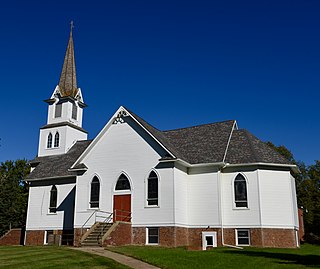
Immanuel Danish Evangelical Lutheran Church is a historic church on W. Second Street in Kimballton, in Audubon County, Iowa. It was built in 1904 and was added to the National Register in 1991. Four years later it was included as a contributing property in the Kimballton West 2nd – West 3rd Street Residential District.
The Chris Larsen House is a historic residence located in Elk Horn, Iowa, United States. It was listed on the National Register of Historic Places in 1991. The historic importance of the house is its association with Danish immigration into Shelby and Audubon counties from 1865 to 1924. It is also the best example in the area of the frame, gabled double-pile house type. It follows a basic foursquare plan with a broad eavefront gabled roof with a broad central gabled dormer, and symmetrical fenestration on the facade. This type of house construction was popular in the local Danish immigrant community from the 1890s into the 1910s. Chris Larsen, who had this house built in 1908, was a local merchant who immigrated to the United States in 1890. He and his wife Amanda had three children, and they had several boarders living with them as well.
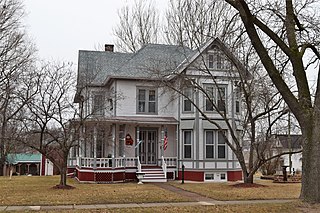
The Robert R. and Julia L. Plane House is a historic residence located in Independence, Iowa, United States. Built in 1885, this 2½-story frame house is locally significant as an intact example of the Stick Style. The construction of the house is attributed to local builder Jacob Manz, a German immigrant who lived in several places in the United States before settling in Independence. The decoration of the house remained consistent, even after an addition was built onto the back and the enlargement of the front porch. Robert and Julia Plane were married in 1882. She was his second wife as his first wife Emeline had died in 1878. He owned a hardware store downtown. The house was listed on the National Register of Historic Places in 1999.

The Kimballton Commercial District is a nationally recognized historic district located in Kimballton, Iowa, United States. It was listed on the National Register of Historic Places in 1995. At the time of its nomination the district consisted of 34 resources, including 26 contributing buildings and 8 non-contributing buildings. The district covers parts of four blocks of the central business district. The commercial buildings are mostly masonry structures constructed with locally produced bricks and concrete blocks. Eleven of the buildings are frame construction. The buildings are from one to two stories in height, and Late Victorian architectural styles dominate. Because of the hilly terrain, buildings on one side of Main Street have exposed basements, while those on the other side of street are built into the side of a hill. The Bennedsen, Boldt, and Hansen Building is individually listed on the National Register.

The Kimballton West 2nd – West 3rd Street Residential District is a nationally recognized historic district located in Kimballton, Iowa, United States. It was listed on the National Register of Historic Places in 1995. At the time of its nomination the district consisted of 82 resources, including 26 contributing buildings, 11 contributing objects, and 27 non-contributing buildings. The district mostly contains houses and outbuildings associated with the dwellings. They are all frame construction with locally produced brick, clay tile block, or concrete block foundations. Most of the lots are large the house size is a matter of taste or preference. For the most part the houses are 1½-stories, but there are also single-story and two-story structures. Residential architectural styles in the district include Queen Anne, Colonial Revival, and American Craftsman. There are no high style examples in the district. The frame, Gothic Revival, Immanuel Lutheran Church (1904) is located on Second Street, and is individually listed on the National Register.
The Bennedsen, Boldt, and Hansen Building, also known as the General Store Museum, is a historic building in Kimballton, Iowa, United States. Its significance is derived from its association with Danish immigrant craftsmen utilizing local produced materials by other Danish immigrants. The single-story brick structure was the work of Niels Bennedsen, Hans P. Boldt (carpenter), and Hans P. Hansen (carpenter). Each owned a ⅓ interest in the property. Although all three were involved in the construction trade it is only known that Bennedsen worked on the building. It is possible that Hansen did the carpentry work and Boldt, who also owned the local lumber yard, supplied the lumber and woodwork.

Hans J. Jorgensen Barn is a historic building located in Kimballton, Iowa, United States. Its significance is derived from its association with Jorgensen, who was the instrumental in the founding and early growth of the town, a Danish immigrant community. The barn is a pyramidal roof variant of the Square Hipped Roof Barn. Built in 1908, it is the only barn of this type that remains in the Danish Settlement area. The concrete blocks used for the foundation and for the adjacent silo, which a part of this historic nomination, were locally produced in a Danish-influenced industry. The two-story heavy-timber structure utilized mortise and tenon construction for the animal stalls and the supports for the hay loft. The barn was listed on the National Register of Historic Places in 1991.
The Hans M. Koch House, also known as the Brickyard Residence, is a historic building located in the extreme southern portion of Kimballton, Iowa, United States. Its significance is derived from its association with the Danish immigrant settlement of the area, and the skilled Danish craftsman who lived and worked here. The house was the work of its owner, Hans Koch, who was also the manager of the Crystals Springs brickyard nearby. He was a native of Slesvig, Denmark and immigrated to the United States twice. He first settled in Michigan in 1893 before returning to Denmark four years later. He immigrated a second time in 1908 settling in Kimballton. He worked as a brickmaker everywhere he lived. Built in 1908, the 1½-story brick structure is a gabled double-pile house type, which was common in the Danish settlement area of Shelby and Audubon counties in the early 20th century. It may also be an example of a Danish house form. It was listed on the National Register of Historic Places in 1991.

The John D. Bush House is a historic building located in Exira, Iowa, United States. Its significance is derived from its association with the skilled Danish immigrant craftsman Jens Uriah Hansen. He was a native of Lourup, Denmark, and was the first Dane to settle in Audubon County. Hansen was responsible for constructing numerous houses and other buildings in the Exira area. This is the only one with a high degree of structural integrity, and reflects Hansen's carpentry skills. Built in 1873, the two-story frame structure rests on a brick foundation. It features an L-shaped plan, and intersecting gabled roofs. John Bush, for whom the house was built, operated an early general store in town and served as the postmaster. The Bush family retained the property until 1935. It was used as a boarding house for five families in the 1930s. The house was listed on the National Register of Historic Places in 1991.
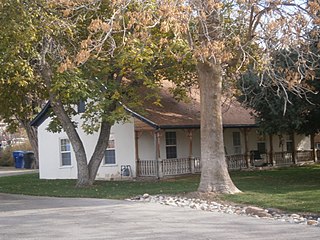
The Anders Hintze House, located at 4249 S. 2300 East in Holladay, Utah, was built in c.1863-64. It is a "Type IIA" pair-house. It was listed on the National Register of Historic Places in 1983.

The Thuesen-Petersen House, located at 260 W. Center St. in Scipio, Utah, is a historic pair-house which was built in c.1870. It was listed on the National Register of Historic Places in 1983.

The Jens Naeset House is an Italianate/Second Empire house built in 1878 in Stoughton, Wisconsin by Norwegian immigrant builder Naeset for his own family. In 1985 it was listed on the National Register of Historic Places.
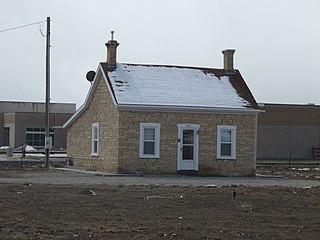
The James and Caroline M. Metcalf House is a historic house in Gunnison, Utah. It was built in 1883, probably for James Metcalf, an immigrant from England who became a sheep and livestock farmer in Utah, and his Denmark-born wife Caroline, the daughter of Hans Larsen, who gave them the plot of land. However, the Metcalfs may have owned but not lived in the house. It was a hall-parlor plan house with Classical Revival-style details. It has been listed on the National Register of Historic Places since July 23, 1998.
The William D. Kuhre House, at 8586 S. 150 East in Sandy, Utah, was built in 1890. It was listed on the National Register of Historic Places in 1987.
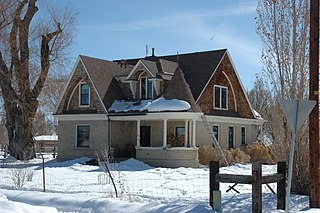
The Lars Peter Larson House is a historic house in Cleveland, Utah. It was built in 1908 for Lars Peter Larson, the son of Danish immigrants who converted to the Church of Jesus Christ of Latter-day Saints. Larson, who worked as farmer, shepherder, and a salesman for the LDS-run Cleveland Cooperative Mercantile Association, lived here with his wife, née Nora Oveson. The house was designed in the Shingle style, and it was meant to resemble a castle. The Larsons moved to Salt Lake City in 1915, and the house was acquired by Joseph Locke, followed by Harry C. Allred, and Ronald Norris. Larson died in Los Angeles in 1962. The house has been listed on the National Register of Historic Places since February 13, 1980.

The Durisol House, also known as the Jens Risom House, is a historic house at 43 Marshall Ridge Road in New Canaan, Connecticut. Built in 1949, this Mid-Century Modern house was built to showcase cement-bonded wood fiber, a newly-developed material marketed under the brand name Durisol. The house was bought soon after its construction by designer Jens Risom, and is also known as the Jens Risom House. It was listed on the National Register of Historic Places in 2010.

















